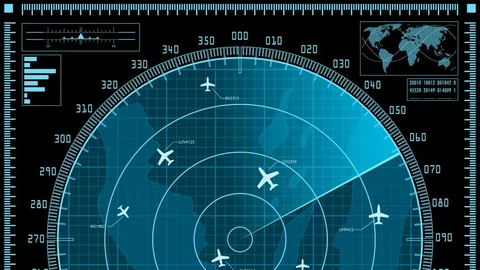The flight tracking system market is estimated to be USD 508.1 million in 2025, and it is projected to reach USD 867.9 million by 2035, growing at a CAGR of 5.48% through the forecast period.
In an era where precision, safety, and real-time visibility define modern aviation, flight tracking systems have emerged as a silent yet transformative force. Once limited to air traffic controllers and major airline operations centers, these systems now sit at the heart of a global push for accountability, efficiency, and situational awareness in the skies.
From enhancing passenger safety to optimizing fleet logistics, the flight tracking system market is evolving rapidly—becoming indispensable not just for airlines, but for governments, logistics providers, and even travelers.
Get Ahead with Our Report: Request Your Sample Now!
https://www.futuremarketinsights.com/reports/sample/rep-gb-610
Real-Time Visibility in an Always-On World
The core appeal of flight tracking lies in its ability to provide real-time data on an aircraft’s position, speed, altitude, and trajectory. In a globally connected airspace, this visibility is essential for reducing uncertainties, avoiding delays, and responding proactively to disruptions.
Whether it’s a commercial jetliner flying over oceans, a cargo aircraft traversing remote regions, or a private jet on a cross-border journey, flight tracking systems ensure that aircraft are never truly out of sight. This continuous situational awareness strengthens safety protocols and empowers decision-makers to act swiftly in times of deviation or emergency.
As aviation becomes more data-driven, flight tracking is no longer optional—it’s fundamental to operational resilience.
Beyond Radar: The Rise of Satellite-Based Tracking
Traditional radar systems, while effective in controlled airspace, have limitations—especially over oceans, mountainous terrain, and polar routes. Modern flight tracking systems overcome these blind spots through satellite-based technologies, such as ADS-B (Automatic Dependent Surveillance–Broadcast), GPS, and satellite communications.
These space-based systems allow aircraft to self-report their position with high accuracy, enabling coverage across virtually the entire globe. Airlines, regulators, and safety agencies now have access to uninterrupted location data, even in regions where radar once fell silent.
This advancement has reshaped how flights are monitored, rerouted, and accounted for—particularly in emergency scenarios. It also supports compliance with international aviation safety recommendations, emphasizing the importance of global cooperation and shared visibility.
Operational Efficiency Meets Predictive Insights
Flight tracking isn’t just about safety—it’s also a key enabler of operational excellence. Airlines use tracking data to improve fleet utilization, manage air traffic congestion, and optimize ground operations. Real-time updates on arrivals and departures allow airports to streamline gate assignments, baggage handling, and refueling schedules.
For logistics companies, tracking systems provide vital information about estimated arrival times, helping reduce supply chain uncertainty and improve customer service. Meanwhile, predictive analytics tools built on historical flight data are helping operators anticipate delays, fuel usage, and maintenance needs with greater accuracy.
The result is a more responsive aviation ecosystem—where inefficiencies are minimized, and resources are deployed where they matter most.
Enhancing Passenger Experience and Transparency
In a world where travelers expect information at their fingertips, flight tracking systems are bringing transparency to the passenger journey. Mobile apps and airline portals now offer live tracking features, allowing customers to follow their flight’s progress in real time.
This access to real-time flight information reduces anxiety, improves trust, and enhances the overall travel experience. Whether checking a loved one’s arrival or planning ground transportation based on accurate ETAs, flight tracking turns data into convenience and assurance.
For airlines, this transparency fosters brand loyalty and helps reduce the load on customer service operations during disruptions or delays.
Security, Compliance, and the Need for Accountability
Flight tracking also plays a growing role in aviation security and regulatory compliance. Governments and international aviation bodies increasingly require accurate flight data to ensure airspace sovereignty, support search and rescue efforts, and mitigate the risk of unauthorized flight activity.
In high-security environments, tracking systems offer layered surveillance—working alongside air traffic control, defense radar, and border protection to detect anomalies and enforce no-fly zones.
Moreover, as incidents involving lost or downed aircraft have underscored the need for better traceability, flight tracking has become a key tool in post-incident investigations and crisis response.
Exhaustive Market Report: A Complete Study
https://www.futuremarketinsights.com/reports/flight-tracking-system-market
Looking Ahead: Integrating with the Digital Cockpit
The future of flight tracking lies in deeper integration with cockpit systems, AI-powered analytics, and next-generation aviation infrastructure. As aircraft become more connected, tracking data will play a larger role in autonomous flight systems, unmanned aerial traffic management, and smart airport operations.
Advanced tracking systems are being designed not only to observe flights but to interpret data in real time—identifying route optimization opportunities, turbulence zones, and even maintenance alerts before they become critical.
Combined with artificial intelligence, blockchain, and 5G communications, flight tracking will increasingly power a proactive, predictive approach to aviation safety and performance.
A Quiet Guardian of the Skies
Flight tracking systems may not draw attention from passengers or dominate headlines, but they are quietly transforming how the aviation industry operates—making skies safer, journeys smoother, and operations smarter.
In a world where visibility equals control, and data equals trust, these systems are more than digital tools—they are the guardians of modern air travel. Whether enabling a safe landing or ensuring a timely delivery, flight tracking is the unseen infrastructure that keeps global mobility flowing.
As airspace becomes more complex and the demand for accountability grows, flight tracking systems are poised to become the nerve center of aviation’s next era—silent, seamless, and always watching.






